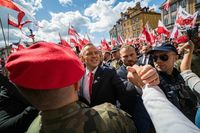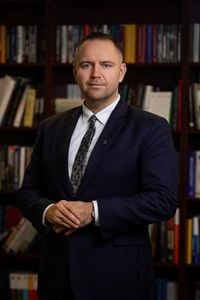Poland’s political landscape has shifted dramatically in recent months, culminating in a diplomatic overture from the White House that’s set to reverberate across Europe. U.S. President Donald Trump has officially invited Poland’s new president, Karol Nawrocki, for a working meeting in Washington on September 3, 2025—a move widely seen as a signal of deepening ties between two staunch allies at a time of regional uncertainty.
The invitation, which was delivered in a congratulatory letter on the very day of Nawrocki’s inauguration, marks a new chapter in Polish-American relations. According to Reuters, Pawel Szefernaker, the chief of Nawrocki’s cabinet, announced on Saturday, “In an official congratulatory letter delivered on the inauguration day, U.S. President Donald Trump invited Polish President Karol Nawrocki to the White House for an official working meeting on September 3, 2025.” The message, shared publicly on X (formerly Twitter), underscores the importance both leaders place on their budding partnership.
Nawrocki, a 42-year-old historian and political newcomer, was sworn in as president on July 30, 2025, after an intense election that saw him defeat his pro-European Union rival in a surprise victory. As Bloomberg reports, “The Trump administration threw its weight behind Nawrocki, an opposition-backed nationalist, in June’s presidential election, where he unexpectedly beat his pro-European Union rival.” This support, especially from a sitting U.S. president, is rare in European politics and highlights the ideological alignment between the two leaders.
During his campaign, Nawrocki was backed by Poland’s main nationalist opposition party, Law and Justice (PiS), although he ran as an independent. His close ties to PiS, combined with his outspoken admiration for Trump, have set him apart from Poland’s current Prime Minister, Donald Tusk, a centrist and longtime critic of both men. As Deutsche Welle notes, Nawrocki is “a right-wing conservative and political opponent of Polish Prime Minister Donald Tusk,” and while “officially independent,” he is “seen as close to the nationalist Law and Justice Party (PiS).”
Nawrocki’s rapid ascent has been nothing short of remarkable. In May 2025, just weeks before the election, he traveled to Washington for a meeting with President Trump in the Oval Office. The White House even published a photograph of the two men giving a thumbs-up—a moment widely interpreted as a public endorsement. According to Deutsche Welle, “The visit and photo were seen as boosting Nawrocki’s chances.” Trump’s support was explicit: he expressed his backing for Nawrocki’s candidacy, a gesture that resonated with Polish voters who favor a strong transatlantic relationship.
The official invitation to Washington, coming so soon after Nawrocki’s inauguration, is more than a diplomatic courtesy. It’s a clear signal of intent. As Devdiscourse puts it, “The meeting is scheduled to take place in Washington at the beginning of September, signaling an intention to strengthen the Polish-U.S. relationship further.” Both leaders have repeatedly emphasized the strategic importance of their countries’ partnership, especially as Poland finds itself on the front lines of a region destabilized by the ongoing war in neighboring Ukraine.
Poland’s role as a NATO member and a steadfast U.S. ally has only grown in recent years. According to Bloomberg, “Poland, a staunch US ally and member of the NATO alliance, spends nearly 5% of its economic output on defense amid the war in neighboring Ukraine.” This level of defense spending is among the highest in Europe and reflects Warsaw’s acute sense of vulnerability in the current security climate. For Washington, Poland’s commitment to NATO and its willingness to shoulder a significant share of the defense burden make it an indispensable partner.
The upcoming meeting between Trump and Nawrocki is expected to focus on a range of issues, from military cooperation to energy security and trade. While the official agenda has not been released, the symbolism of the encounter is hard to overstate. For Nawrocki, the visit offers an opportunity to cement his credentials as a leader capable of navigating the complexities of global diplomacy. For Trump, it’s a chance to showcase the success of his administration’s outreach to Central and Eastern Europe, as well as to reinforce his administration’s preference for nationalist-leaning allies.
Political observers in both countries are already speculating about the implications of the meeting. Nawrocki’s victory, backed by the Law and Justice party, has been interpreted by some as a shift away from the pro-European Union stance favored by his predecessor and Prime Minister Tusk. However, others argue that Poland’s security concerns and its proximity to Russia mean that transatlantic ties will remain paramount, regardless of the political party in power. The invitation from Trump—delivered so promptly after Nawrocki’s swearing-in—suggests that Washington is eager to deepen cooperation with Warsaw, especially on defense and regional security.
Yet, the meeting is not without its potential controversies. Nawrocki’s nationalist credentials and his opposition to the current Polish government could complicate relations within the European Union, where tensions between Brussels and Warsaw have flared in recent years over issues such as judicial independence and media freedom. For Trump, the optics of embracing a right-wing, opposition-backed leader may draw criticism from some quarters, but it aligns with his administration’s broader approach to foreign policy—favoring bilateral relationships and pragmatic alliances over multilateralism.
Despite the political undercurrents, the personal rapport between Trump and Nawrocki appears genuine. Their Oval Office meeting in May 2025, complete with a thumbs-up photo op, was widely covered in the Polish press and seen as a boost for Nawrocki’s campaign. According to Reuters, Nawrocki “has on many occasions emphasized the importance of good Polish-U.S. relations.” The upcoming White House visit is likely to reinforce that message, both at home and abroad.
As September approaches, all eyes will be on Washington to see what emerges from the Trump-Nawrocki summit. Will it lead to new defense agreements, closer economic ties, or a joint stance on regional security? Whatever the outcome, the invitation itself marks a significant moment in the evolving relationship between Poland and the United States—a partnership forged in the crucible of history and tested by the challenges of the present.
With Poland facing a volatile neighborhood and the United States seeking reliable allies, the meeting between Trump and Nawrocki is set to shape the trajectory of transatlantic relations for years to come.





